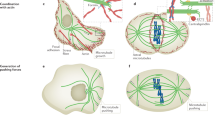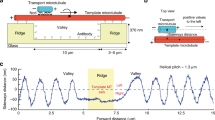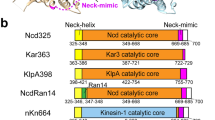Abstract
The microtubule cytoskeleton is a dynamic structure in which the lengths of the microtubules are tightly regulated. One regulatory mechanism is the depolymerization of microtubules by motor proteins in the kinesin-13 family1. These proteins are crucial for the control of microtubule length in cell division2,3,4, neuronal development5 and interphase microtubule dynamics6,7. The mechanism by which kinesin-13 proteins depolymerize microtubules is poorly understood. A central question is how these proteins target to microtubule ends at rates exceeding those of standard enzyme–substrate kinetics8. To address this question we developed a single-molecule microscopy assay for MCAK, the founding member of the kinesin-13 family9. Here we show that MCAK moves along the microtubule lattice in a one-dimensional (1D) random walk. MCAK–microtubule interactions were transient: the average MCAK molecule diffused for 0.83 s with a diffusion coefficient of 0.38 µm2 s-1. Although the catalytic depolymerization by MCAK requires the hydrolysis of ATP, we found that the diffusion did not. The transient transition from three-dimensional diffusion to 1D diffusion corresponds to a “reduction in dimensionality”10 that has been proposed as the search strategy by which DNA enzymes find specific binding sites11. We show that MCAK uses this strategy to target to both microtubule ends more rapidly than direct binding from solution.
This is a preview of subscription content, access via your institution
Access options
Subscribe to this journal
Receive 51 print issues and online access
$199.00 per year
only $3.90 per issue
Buy this article
- Purchase on Springer Link
- Instant access to full article PDF
Prices may be subject to local taxes which are calculated during checkout




Similar content being viewed by others
References
Desai, A., Verma, S., Mitchison, T. J. & Walczak, C. E. Kin I kinesins are microtubule-destabilizing enzymes. Cell 96, 69–78 (1999)
Maney, T., Hunter, A. W., Wagenbach, M. & Wordeman, L. Mitotic centromere-associated kinesin is important for anaphase chromosome segregation. J. Cell Biol. 142, 787–801 (1998)
Rogers, G. C. et al. Two mitotic kinesins cooperate to drive sister chromatid separation during anaphase. Nature 427, 364–370 (2004)
Walczak, C. E., Mitchison, T. J. & Desai, A. XKCM1: a Xenopus kinesin-related protein that regulates microtubule dynamics during mitotic spindle assembly. Cell 84, 37–47 (1996)
Homma, N. et al. Kinesin superfamily protein 2A (KIF2A) functions in suppression of collateral branch extension. Cell 114, 229–239 (2003)
Tournebize, R. et al. Control of microtubule dynamics by the antagonistic activities of XMAP215 and XKCM1 in Xenopus egg extracts. Nature Cell Biol. 2, 13–19 (2000)
Mennella, V. et al. Functionally distinct kinesin-13 family members cooperate to regulate microtubule dynamics during interphase. Nature Cell Biol. 7, 235–245 (2005)
Hunter, A. W. et al. The kinesin-related protein MCAK is a microtubule depolymerase that forms an ATP-hydrolyzing complex at microtubule ends. Mol. Cell 11, 445–457 (2003)
Wordeman, L. & Mitchison, T. J. Identification and partial characterization of mitotic centromere-associated kinesin, a kinesin-related protein that associates with centromeres during mitosis. J. Cell Biol. 128, 95–104 (1995)
Adam, G. & Delbruck, M. in Structural Chemistry of Molecular Biology (eds Rich, A. & Davidson, N.) 198–215 (Freeman, San Francisco, 1968)
Richter, P. H. & Eigen, M. Diffusion controlled reaction rates in spheroidal geometry. Application to repressor–operator association and membrane bound enzymes. Biophys. Chem. 2, 255–263 (1974)
Moores, C. A. et al. A mechanism for microtubule depolymerization by KinI kinesins. Mol. Cell 9, 903–909 (2002)
Niederstrasser, H., Salehi-Had, H., Gan, E. C., Walczak, C. & Nogales, E. XKCM1 acts on a single protofilament and requires the C terminus of tubulin. J. Mol. Biol. 316, 817–828 (2002)
Mandelkow, E. M., Mandelkow, E. & Milligan, R. A. Microtubule dynamics and microtubule caps: a time-resolved cryo-electron microscopy study. J. Cell Biol. 114, 977–991 (1991)
Hyman, A. A., Salser, S., Drechsel, D. N., Unwin, N. & Mitchison, T. J. Role of GTP hydrolysis in microtubule dynamics: information from a slowly hydrolyzable analogue, GMPCPP. Mol. Biol. Cell 3, 1155–1167 (1992)
Northrup, S. H. & Erickson, H. P. Kinetics of protein–protein association explained by Brownian dynamics computer simulation. Proc. Natl Acad. Sci. USA 89, 3338–3342 (1992)
Howard, J. Mechanics of Motor Proteins and the Cytoskeleton (Sinauer, Sunderland, Massachusetts, 2001)
Kalaidzidis, Y. L., Gavrilov, A. V., Zaitsev, P. V., Kalaidzidis, A. L. & Korolev, E. V. PLUK—an environment for software development. Program. Comput. Softw. 23, 206–211 (1997)
Howard, J., Hudspeth, A. J. & Vale, R. D. Movement of microtubules by single kinesin molecules. Nature 342, 154–158 (1989)
Klein, G. A., Kruse, K., Cuniberti, G. & Julicher, F. Filament depolymerization by motor molecules. Phys. Rev. Lett. 94, 108102 (2005)
Paschal, B. M., Obar, R. A. & Vallee, R. B. Interaction of brain cytoplasmic dynein and MAP2 with a common sequence at the C terminus of tubulin. Nature 342, 569–572 (1989)
Maney, T., Wagenbach, M. & Wordeman, L. Molecular dissection of the microtubule depolymerizing activity of mitotic centromere-associated kinesin. J. Biol. Chem. 276, 34753–34758 (2001)
Ovechkina, Y., Wagenbach, M. & Wordeman, L. K-loop insertion restores microtubule depolymerizing activity of a ‘neckless’ MCAK mutant. J. Cell Biol. 159, 557–562 (2002)
Thorn, K. S., Ubersax, J. A. & Vale, R. D. Engineering the processive run length of the kinesin motor. J. Cell Biol. 151, 1093–1100 (2000)
Wang, Z. & Sheetz, M. P. The C-terminus of tubulin increases cytoplasmic dynein and kinesin processivity. Biophys. J. 78, 1955–1964 (2000)
Nitta, R., Kikkawa, M., Okada, Y. & Hirokawa, N. KIF1A alternately uses two loops to bind microtubules. Science 305, 678–683 (2004)
Hackney, D. D. Kinesin ATPase: Rate-limiting ADP release. Proc. Natl Acad. Sci. USA 85, 6314–6318 (1988)
Riggs, A. D., Bourgeois, S. & Cohn, M. The lac repressor–operator interaction. 3. Kinetic studies. J. Mol. Biol. 53, 401–417 (1970)
Winter, R. B., Berg, O. G. & von Hippel, P. H. Diffusion-driven mechanisms of protein translocation on nucleic acids. 3. The Escherichia coli lac repressor–operator interaction: kinetic measurements and conclusions. Biochemistry 20, 6961–6977 (1981)
Halford, S. E. & Marko, J. F. How do site-specific DNA-binding proteins find their targets? Nucleic Acids Res. 32, 3040–3052 (2004)
Acknowledgements
We thank R. Hartmann for cloning and protein purification work; V. Varga for purification of unlabelled MCAK; E. Schäffer for the application of F-127; F. Ruhnow for the two-dimensional gaussian peak-fitting tool; A. Hyman, F. Jülicher, E. Schäffer, I. Riedel, J. Stear, G. Klein, V. Varga, A. Hunt and H. T. Schek for review of the manuscript; and S. Wolfson for proofreading and editing. Andor Technologies lent us the Andor iXon camera, and the VisiTIRF condenser was developed in collaboration with Visitron Imaging Systems, GmbH. This research was supported by the Max Planck Gesellschaft and the NIH.
Author information
Authors and Affiliations
Corresponding author
Ethics declarations
Competing interests
Reprints and permissions information is available at npg.nature.com/reprintsandpermissions. The authors declare no competing financial interests.
Supplementary information
Supplementary Notes
This file contains Supplementary Notes, Supplementary Methods and legends for Supplementary Videos. (PDF 1504 kb)
Supplementary Video 1
This movie shows MCAK-induced depolymerization of microtubules. Epifluorescence images (TRITC) of immobilized microtubules were recorded with 10s intervals for 12 minutes. At 4 minutes, buffer containing 4 nM MCAK was added, resulting in the depolymerization of microtubules at 1.5 µm•min-1. Video playback is 100x real-time. (MOV 6016 kb)
Supplementary Video 2
This movie shows MCAK–GFP molecules (green) diffusing along microtubules (red) in 1 mM ATP. 0.5 nM MCAK-GFP was used. The TIRF images (FITC) were recorded in continuous mode at 100 ms per frame and overlaid onto one static epifluorescence image (TRITC) of the microtubules. Video playback is in real-time. (MOV 6039 kb)
Supplementary Video 3
This movie shows MCAK–GFP molecules (green) diffusing along microtubules (red) in 1 mM ADP. 0.5 nM MCAK-GFP was used. The TIRF images (FITC) were recorded in continuous mode at 100 ms per frame and overlaid onto one static epifluorescence image (TRITC) of the microtubules. Video playback is in real-time. (MOV 8912 kb)
Rights and permissions
About this article
Cite this article
Helenius, J., Brouhard, G., Kalaidzidis, Y. et al. The depolymerizing kinesin MCAK uses lattice diffusion to rapidly target microtubule ends. Nature 441, 115–119 (2006). https://doi.org/10.1038/nature04736
Received:
Accepted:
Issue Date:
DOI: https://doi.org/10.1038/nature04736
This article is cited by
-
A synthetic tubular molecular transport system
Nature Communications (2021)
-
Regulation of microtubule dynamics, mechanics and function through the growing tip
Nature Reviews Molecular Cell Biology (2021)
-
Exploring the speed limit of toehold exchange with a cartwheeling DNA acrobat
Nature Nanotechnology (2018)
-
Ternary complex of Kif2A-bound tandem tubulin heterodimers represents a kinesin-13-mediated microtubule depolymerization reaction intermediate
Nature Communications (2018)
-
Microtubule dynamics: an interplay of biochemistry and mechanics
Nature Reviews Molecular Cell Biology (2018)
Comments
By submitting a comment you agree to abide by our Terms and Community Guidelines. If you find something abusive or that does not comply with our terms or guidelines please flag it as inappropriate.



